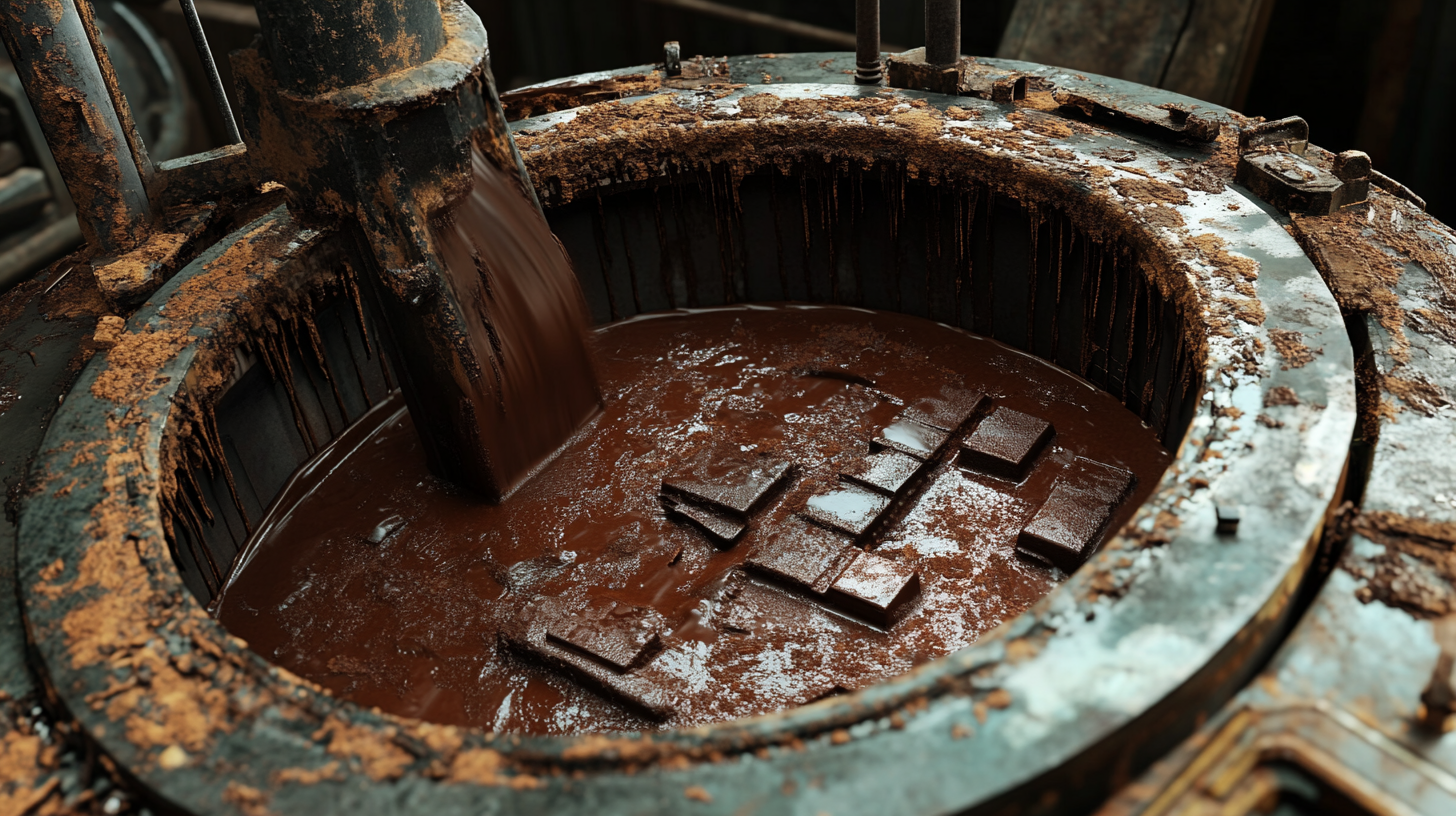In the world of chocolate production, achieving the perfect blend of flavors and textures is paramount, and the efficiency of the Chocolate Mixing Machine plays a crucial role in this process. However, manufacturers often encounter a range of challenges that can hinder optimal performance and output. Factors such as inconsistent ingredient quality, machine calibration issues, and maintenance protocols can significantly affect the mixing process, leading to subpar product results. Additionally, the rapid pace of technological advancements requires ongoing adaptation and innovation to meet evolving market demands. This blog will explore these challenges in depth, highlighting the importance of optimizing the Chocolate Mixing Machine for improved efficiency and product quality. By understanding these obstacles, manufacturers can implement effective strategies to enhance their chocolate mixing operations and ultimately create superior chocolate products that satisfy consumer expectations.

The efficiency of chocolate mixing machines plays a crucial role in the overall production process of confectionery manufacturing. According to a report by Smithers Pira, inefficiencies in mixing can lead to increased production costs by approximately 15%. As chocolate manufacturers strive to meet consumer demand for quality products, optimizing mixing processes is essential. Efficient machines not only reduce energy consumption but also improve batch consistency, leading to a higher quality end product.
Industry data highlights that investing in high-performance mixing technology can yield significant returns. A study by Food Processing Technology indicates that modern chocolate mixing machines can enhance mixing speeds by up to 30%, cutting down production time dramatically. This acceleration allows manufacturers to respond swiftly to market demands without sacrificing the uniformity of flavor and texture, which is paramount in the chocolate industry. Companies that embrace these advanced technologies can elevate their production capabilities, ensuring they remain competitive in a fast-evolving market.

Chocolate mixing machines play a vital role in the production of high-quality chocolate products. However, several operational challenges can hinder their efficiency, affecting the overall production process. One common issue is the inconsistency in the mixing process, which can lead to uneven textures and flavors. This inconsistency may arise from improper calibration or variations in ingredient quality. To combat this, manufacturers should regularly maintain and calibrate their machines, ensuring precise measurements and uniform mixing.
Another significant challenge is the buildup of chocolate residue within the machinery. This not only affects the taste of subsequent batches but can also lead to operational delays. It's essential to implement a thorough cleaning schedule after production runs to prevent residue accumulation. Additionally, using non-stick coatings can help in minimizing chocolate adhesion, making cleaning easier and enhancing the machine’s efficiency.
Lastly, machine breakdowns can severely impact production timelines. Regular inspections and prompt repairs are crucial for preventing unexpected downtimes. Investing in high-quality parts and attentive maintenance can extend the life of chocolate mixing machines and improve their reliability. Adopting these best practices can significantly enhance the efficiency and consistency of chocolate production.
| Challenge | Description | Impact on Efficiency | Possible Solutions |
|---|---|---|---|
| Inconsistent Mixing | Variation in ingredient distribution leading to uneven chocolate quality. | Decreased product quality and increased waste. | Regular calibration and ingredient pre-mixing protocols. |
| Temperature Control | Difficulty in maintaining optimal temperature throughout the mixing process. | Affects the viscosity and texture of chocolate. | Invest in advanced temperature monitoring systems. |
| Mechanical Failures | Breakdowns of mixing blades or motors during operation. | Downtime leading to lost production time and costs. | Scheduled maintenance and using durable materials. |
| Ingredient Variability | Different batches of ingredients can have varying properties. | Affects consistency and predictability of results. | Quality checks and ingredient standardization. |
| Cleaning Processes | Time-consuming cleaning that interrupts production. | Reduces overall production efficiency and throughput. | Implementing quick-clean technologies and protocols. |
The efficiency of chocolate mixing machines is significantly influenced by the quality of the ingredients used. Research indicates that incorporating high-quality cocoa solids and fats can enhance the mixing process, leading to a more homogeneous blend. According to a report by the International Cocoa Organization, the use of premium cocoa can improve the final product's viscosity by up to 15%, allowing for smoother processing. This viscosity control is crucial, as it directly impacts the flow characteristics of the mixture during production.
Moreover, ingredient quality affects not only the mixing efficacy but also the operational downtime. In a study published by the Confectionery Manufacturing Association, it was found that machines tasked with mixing lower-quality ingredients experienced a 20% increase in maintenance issues, resulting in prolonged production halts. Conversely, manufacturers that prioritize high-quality ingredients reported a 30% reduction in maintenance costs, underlining the importance of quality in sustaining mixing machine performance. As the industry continues to evolve, manufacturers must recognize that the foundation of efficiently operating mixing machinery begins with the careful selection of ingredients.

Technological innovations are revolutionizing the efficiency of mixing processes across various industries. For instance, the introduction of plug-and-play solutions has shown promising potential in maximizing performance while reducing energy consumption. Such advancements are essential for optimizing operations in sectors like battery manufacturing, where effective slurry mixing is critical for improving lithium-ion battery performance. This surge in innovative mixing technologies highlights the industry's focus on sustainability and efficiency.
To achieve improved mixing efficiency, it’s vital for operators to select the right equipment tailored to their specific needs. Here are a few tips:
1. Regularly assess the performance of mixing machinery to identify areas for improvement.
2. Invest in state-of-the-art technologies that provide flexibility and consistency, especially for applications like pet food blending.
3. Stay updated with market trends to ensure that your mixing solutions align with the latest innovations, aiding in energy efficiency and cost-effectiveness.
Moreover, with the ongoing expansion of the asphalt mixing plants market driven by novel technologies, it’s clear that businesses must adapt to these changes to maintain a competitive edge. By embracing innovation, companies can transform their mixing processes and enhance overall operational efficiency.
Maintaining optimal efficiency in chocolate mixing processes is crucial for ensuring product quality and maximizing production output. Recent industry reports indicate that a well-optimized chocolate mixing machine can elevate production efficiency by up to 25%. To achieve this, implementing best practices such as regular equipment maintenance, precise temperature control, and effective ingredient management is essential. Regularly scheduled maintenance helps to prevent mechanical failures that can lead to downtime, while precise temperature control ensures that cocoa butter and other ingredients blend seamlessly, resulting in a smoother product.
Moreover, the integration of advanced Manufacturing Execution Solutions (MES) can significantly enhance the flexibility and efficiency of chocolate production. By utilizing MES, manufacturers can gain real-time insights into the mixing process, optimize ingredient usage, and reduce waste. For instance, a recent case study showed that a prominent manufacturer was able to reduce production cycle times by 15% after adopting a holistic MES approach. Additionally, the use of data analytics allows for continuous monitoring and adjustments, which can elevate the mixing performance and lead to more consistent final products, ultimately satisfying evolving consumer demands.
This bar chart represents the efficiency challenges faced in chocolate mixing processes, showcasing the percentage of time lost due to different factors such as Equipment Downtime, Ingredient Quality Issues, and Operator Errors. Maintaining optimal efficiency is essential for quality production.
For more information, fill out our contact form